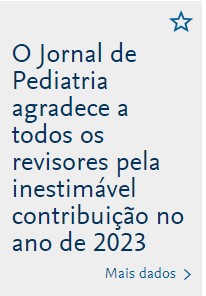To estimate the prevalence of high blood pressure (BP) in school children, as well as the reported frequency of previous measurements of BP in these children, and to identify high BP risk markers in the sample.
MethodsThis was a cross-sectional study involving 794 children aged 6 to 13 years, enrolled in public elementary schools. A questionnaire was given to parents/guardians, consisting of perinatal, socioeconomic data, and information on previous measurements of BP in these children. Anthropometric measurements included weight, height, waist, hip, and arm and neck circumference, in addition to the three BP measurements. Classification of BP levels was carried out according to current international recommendations, established in 2004.
ResultsThe prevalence of high BP (hypertension or prehypertension) was 7%. Only 21.7% of children had previously undergone BP measurements. The odds ratio of high BP among children with and without overweight was 2.9 (95% CI = 1.7 to 5.0, p < 0.001). None of the anthropometric measurements was superior to the Z-score of BMI as a predictor of high BP. History of hypertension during pregnancy (p < 0.001), prematurity (p = 0.006), maternal hypertension (p = 0.01), and paternal hypertension (p = 0.008) were also correlated with the presence of high BP in children.
ConclusionsOverweight and family history constitute the main risk markers of high BP in children. The low frequency of BP measurement in children observed in this municipality contributes to the underdiagnosis of the disease, with irreversible consequences for these individuals.
Estimar a prevalência de pressão arterial (PA) elevada em escolares, assim como a frequência relatada de aferição prévia da PA nessas crianças. Identificar marca- dores de risco de PA elevada na amostra.
MétodosEstudo transversal envolvendo 794 crianças de 6 a 13 anos, matriculadas no ensino público fundamental. Questionário entregue aos pais, com informações perina- tais, sócio-econômicas e sobre aferição prévia da PA nas crianças. Avaliação antropo- métrica: peso, altura, circunferências abdominal, de quadril, braquial e cervical, além das três aferições da pressão arterial. Classificação dos níveis pressóricos conforme as recomendações internacionais atuais, estabelecidas em 2004.
ResultadosA prevalência de PA elevada (hipertensão ou pré-hipertensão) foi de 7%. Apenas 21,7% das crianças haviam sido previamente submetidas a aferições de PA. A razão de chances de PA elevada entre crianças com e sem excesso de peso foi de 2,9 (IC 95% = 1,7 a 5,0, p < 0,001). Nenhuma das medidas antropométricas foi superior ao Z de IMC como preditor de PA elevada. Histórico de hipertensão na gestação (p < 0,001), de prematuridade (p = 0,006), hipertensão materna (p = 0,01) e hipertensão paterna (p = 0,008) também se correlacionaram à presença de PA elevada nas crianças.
ConclusõesExcesso de peso e história familiar configuram como principais marcadores de risco de PA elevada em crianças. A baixa frequencia de aferição da PA observada em crianças deste município contribui para o subdiagnóstico da doença, com consequências futuras irreversíveis para esses indivíduos.
Como citar este artigo: Fuly JT, Giovaninni NP, Marcato DG, Alves ER, Sampaio JD, Moraes LI, et al. Evidence of underdiagnosis and markers of high blood pressure risk in children aged 6 to 13 years. J Pediatr (Rio J). 2014;90:65-70.
Estudo conduzido na Universidade Vila Velha, ES (UVV-ES), Vitória, ES, Brasil.









